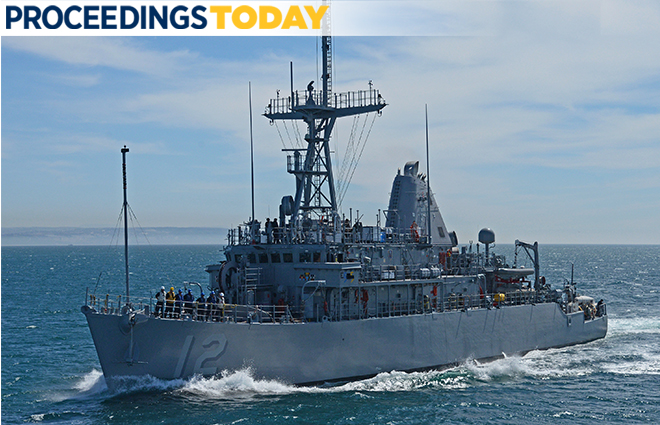 Admittedly, the stakes are increasing in the Surface Force, but the CO is more rather than less important in this challenging environment in the wake of high-profile accidents and the revival of great power competition.
Admittedly, the stakes are increasing in the Surface Force, but the CO is more rather than less important in this challenging environment in the wake of high-profile accidents and the revival of great power competition.
For starters, Commander, Naval Surface Forces, Vice Admiral Rich Brown, clearly believes in the primacy of COs and in our judgement. From his first communication via “Personal For” message to his commanders through this fall’s Commanders’ Training Symposium, his consistent message is one of empowerment and reducing administrative burdens while setting thresholds for minimum requirements in the force. [1]
The new Surface Force Training and Readiness Manual (SFTRM) streamlines the qualification process, and, for ships with strong leaders and capable crews, dramatically decreases training redundancies while giving valuable time back to the Captain. A day at sea is great, but a day at sea without inspectors on board is better. The SFTRM allows ships to forgo the previous block training and incorporates our most qualified watchstanders into mission area certification—changes that incentivize COs and give training time back to the crews of prepared ships. [2]
Revoking the previous Surface Force training instruction empowered COs to make training programs that truly work for our Sailors and crews. [3]
I am one of the Navy’s most junior commanding officers. As an “early command” captain of a minesweeper, I should be the most micromanaged. The reality is the opposite. I have remarkable latitude to do my job, and I am intrinsically empowered to do it. With due credit to my supportive immediate superior in command (ISIC) and his predecessor, I never have felt that the success or failure of the ship is anyone’s responsibility other than my own. Yes, occasionally a leader up my chain of command takes a strong interest in what my ship is doing, but questions asked of me are only to ensure I have sufficient resources (funding, parts, maintenance team support) to do my job.
One of the beauties of our aging mine countermeasures force is that we have old communications suites. This means sometimes I am not reachable at sea. Don’t fret—my superiors don’t. I am trusted and trained to handle the ship safely and conduct my mission. Additionally, just because an email arrives in my inbox does not mean it has to be answered immediately. I think back to my expeditionary training in which I learned to “shoot, move, communicate” in that order. Do your job first, and then communicate.
Comprehensive Review/Strategic Readiness Review-directed and Surface Force-directed initiatives are enablers rather than detractors from readiness and autonomy. Recently established policy changes:
Develop a stronger officer training continuum
Streamline deployment certification processes
Invest in simulator training to help bridge the gap for ships in prolonged in-port periods
Remove cumbersome training program requirements
Establish logbooks to balance talent-to-task on the bridge
Provide simple baseline requirements for standing orders that enable watchstanders to quickly re-qualify on new platforms without worrying about where to find permission items or platform-specific information
These efforts strengthen my ability to do my job by giving me more capable officers on the bridge, less distracting training requirements, and a simple “floor” for minimum performance.
Additionally, rigorous assessments and quality checks provide valuable indicators of competency in the Surface Force—a win for COs and senior decision makers.
With a multitude of shipboard requirements, those of us on ships—and in command of ships—make daily and hourly decisions about where and how to spend our limited time and finite resources. Which programs, sailors, officers, equipment, and spaces need attention? Which must wait for another day? It is our job to make these risk decisions, establish priorities, and set the standards. As a commanding officer, I consistently seek to prioritize, diminish distractions, eliminate redundancies, and focus on the basics of ship handling first and tactics second. I am the most experienced person on my ship. I establish the standard, hold the standard, and work hard to imbue my sailors with that standard.
The Surface Force has challenges aplenty, but erosion of the role of the commanding officer is not one. In a utopian future, administrative requirements disappear and COs spend our days driving ships and practicing with our crews at gunnery quarters. In the meantime, we fit in the administrative tasks when we must, and we understand that we own the problem and the solution. Commanding officers own the fight.
[1] Commander Naval Surface Forces message date-time group 230035Z Jan 18, Personal For ComNavSurFor Commanders and Commanding Officers from Vice Admiral Brown; ComNavSurFor message 242355Z OCT 18, Personal For ComNavSurFor Commanders and Commanding Officers – 2018 ComNavSurfPac Commander’s Training Symposium Read Out
[2] ComNavSurfLant/Pac Instruction 3502.7, Surface Force Training and Readiness Manual, 01 November 2018.
[3] ComNavSurFor message 232126Z OCT 18, Cancellation of the Shipboard Training Programs Instruction.
Lieutenant Commander Reppert is the commanding officer of the USS Ardent (MCM-12). She is a 2006 graduate of the U.S. Naval Academy and has a master’s degree in security studies from Georgetown University’s School of Foreign Service. Her prior sea duty assignments include the USS Lassen (DDG-82), USS Carter Hall (LSD-50), and USS Truxton (DDG-103)
No comments:
Post a Comment